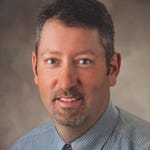October 14, 2020

In the first weeks of the COVID-19 pandemic, our nation’s food system was in the spotlight with temporarily empty grocery shelves and shortages of milk, beef and other staples. It gave all of us — farmers and consumers alike — a new perspective on our food system.
There are lots of lessons from COVID-19 that I’m sure we’ll be reviewing and discussing for years to come. In the short term, it was a good reminder of the importance of communication and collaboration at every step of the food system.
We’ve always known that our dairy cows have two careers: one to produce milk and another to produce beef. It is more important than ever that we think about both those careers as we care for animals throughout their entire lives.
Everything in the food supply starts on the farm. As dairy farmers, we’ve made tremendous progress in caring for animals and ensuring the best quality milk and beef products for consumers.
Programs such as Dairy Beef Quality Assurance and FARM (Farmers Assuring Responsible Management) have brought consistency and standards to many of the management practices dairy producers have been adopting over the years, including animal handling, transportation and record-keeping.
On our farm, we’ve been working to implement the Food Armor antimicrobial stewardship solutions program. In partnership with our veterinarian, Food Armor has helped us understand antibiotic management — particularly how to make treatment decisions and communicate those decisions with our teams. As a result, we’ve been able to treat fewer animals, save money and reduce residue risk, all while improving animal care and health.
Collaboration
Across the industry, partnerships between beef and dairy organizations are providing training and valuable news updates. Educational programs about dairy- and beef-breeding programs and guidelines for culling decisions provide value to dairy farmers and ensure a higher-quality beef supply.
In recent months, programs like Professional Dairy Producers’ The Dairy Signal webinars have brought together experts from across the industry to share information about the status of dairy and beef markets, processing plants, regulations, and markets. When plant capacity was impacted by the pandemic, these updates were critical to our farm to understand the potential impacts on cull cow and other markets.
Transparently sharing information about dairy and beef with consumers is critical. We’ve seen increasing demand for our products and have had opportunities to continue building trust. Both dairy and beef checkoffs have stepped up with communication programs and campaigns to share information and increase demand. As producers, we can do our part by answering questions and sharing our stories in conversations with friends, family and neighbors, and on social media.
Quality dairy animals become quality beef. It’s up to all of us to keep learning, improving our operations and working together to build trust. All of us will benefit.

Read more about:
Covid 19You May Also Like




